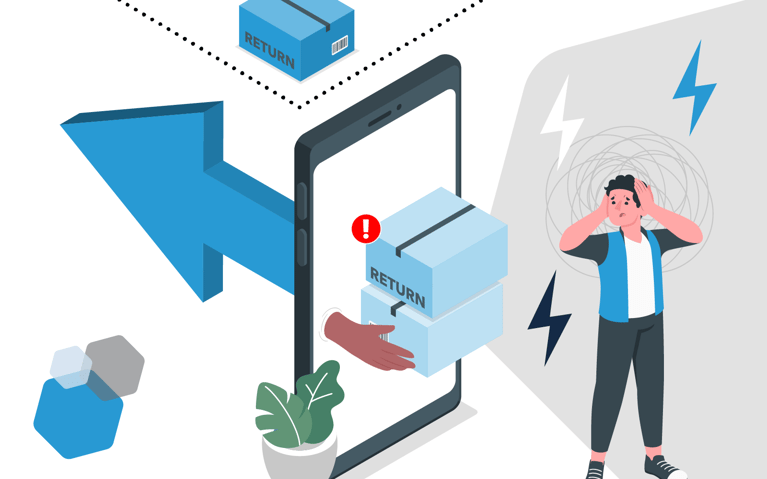The holiday season is a magical time for organizations as customers increase their shopping efforts to buy gifts and search for deals. However, along with the surge in buying, there is also an influx in returns.
Initially, many companies may view returns as a logistical headache, but a well-designed returns policy can be a useful tool to build trust, enhance customer loyalty and drive future sales. With a solid holiday returns policy, businesses can reduce friction for customers and turn a negative experience into a positive one.
The following sections will provide an overview of holiday returns policies and a closer look at turning returns into opportunities.
What is the impact of holiday returns on your business?
It can be easy to take returns personally, but they're a natural part of the holiday shopping season. In fact, around 15% of holiday purchases are returned each year due to gift exchanges or unmet consumer expectations. While returns may seem like a financial and shipping burden, a seamless returns process can lead to higher long-term profits through increased customer trust. Unlike returns during other times of the year, holiday shoppers expect more flexibility when it comes to returning an item.
According to a recent survey, 82% of customers agreed that an easy returns experience would encourage them to shop with a retailer again. Brands without a customer-friendly holiday returns policy can drastically harm their ability to retain customers in the new year.
What are the defining characteristics of a customer-friendly holiday returns policy?
Simply having a returns policy isn't likely to meet the expectations of today's consumers. To drive loyalty, companies must focus on developing a customer-friendly returns policy, especially around the holidays.
To have an effective returns program, your company should focus on developing a simple, quick and painless policy. Below are a few key characteristics that can help turn your current policy into a tool for driving repeat business.
Extended return windows
One of the defining characteristics of a customer-focused holiday returns policy is flexibility, especially in the form of extended return windows. The holiday season is a busy time for shoppers, and many purchase gifts weeks or months in advance. Offering an extended return period through the end of January gives customers the confidence to shop early without the fear that the gifts they buy won't be returnable by the recipient.
Longer return windows can also help reduce purchase hesitation throughout the buying process. When shoppers know they have ample time to return items, they feel more secure in their purchasing decisions.
Free and easy returns
In today's market, customers expect free or at least low-cost return options for their purchases. A recent survey revealed that 63% of shoppers would be more likely to complete a purchase if the company offered free returns. Offering a free return may seem like a hassle internally. However, it's a great way to reduce friction throughout the buying journey.
Multiple return methods
Along with flexibility and no-cost returns, a customer-friendly holiday returns policy should provide convenience for consumers. Offering multiple return methods shows that your business puts the customer's needs first. Instead of having a single return point, provide additional options like returning items in-store or shipping a purchase back from home. By offering multiple options, customers can choose the method that works best for them.
Clear guidelines
Even the best returns policies can provide lackluster results if they aren't clear. Clarity is crucial when it comes to setting expectations throughout the returns process. Your team's holiday returns policy should highlight what qualifies for a return. For instance, if customers can't return opened packages, that should be listed clearly in the document. Likewise, if there are requirements around product tags, make sure they are called out and not buried deep in the policy.
How can your organization streamline the returns process to improve customer experience?
Returning a product can be a nightmare for customers, with many policies requiring multiple hoops to jump through. However, the current consumer perception allows organizations to improve customer experience.
Instead of instructing customers to print their own labels, supply a pre-printed return label in the original package. This simple task can significantly impact how smooth the returns process goes.
Below are a few additional ways your company can streamline returns during the holidays:
- QR codes for return drop-off
- Fast refunds
- Automated return portals
- Proactive communication
3 Ways to turn returns into opportunities for your team
Even though it may seem like a return is the end of a customer relationship, there are ways companies can turn a return into an opportunity.
- Cross-selling during the returns process: Viewing a return as lost revenue is normal. However, the returns process offers a cross-selling opportunity for organizations. When customers initiate a return, suggest similar or complementary items that may suit their needs better. Many eCommerce platforms will allow you to automate this type of product suggestion. Automation tools can also help deliver personalized cross-sell recommendations based on customer preferences or purchase history, making it a great strategy for post-return communication.
- Incentivize store credit: Another way to increase future sales with customers making a return is to incentivize store credit. Many companies that deploy incentivized returns often offer an additional 10% credit when customers choose store credit instead of cash back. While this may seem like a money-losing strategy, it encourages customers to remain within the company's ecosystem and increases the chances for future purchases.
- Follow up after a return: Creating a seamless return experience can positively impact customer satisfaction. However, if you want to maximize customer experience, it's important to have follow-up communication after a return. Reaching out to a customer after a return shows that you care about the customer's experience beyond the transaction. The communication can be as simple as an email or as robust as a complete win-back campaign. Regardless of your chosen approach, remember to ask for feedback, thank the customer for their time and offer a discount or exclusive offer to incentivize future purchases.
Maximize customer experience throughout the returns process with Cart.com
A well-thought-out and executed holiday returns policy can set your business apart during the year's busiest shopping season. Making the returns process easy for customers can help create lasting brand loyalty while improving overall customer satisfaction. If your organization is looking to improve its current returns program, working with a strategic partner like Cart.com is a great place to start.
Cart.com combines best-in-class fulfillment software with a team of experienced supply chain professionals to help organizations enhance their customer experience. Contact our team today to learn how we can help improve brand loyalty and customer experience through a consumer-centric holiday returns program.
Subscribe to our emails for the latest industry insights!
By entering your email, you agree to receive marketing emails from Cart.com







